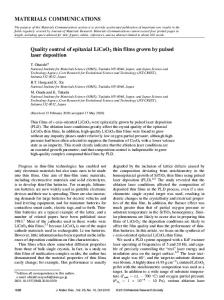Investigation of nitrogen-doped TiO 2 thin films grown by reactive pulsed laser deposition
- PDF / 484,332 Bytes
- 6 Pages / 612 x 792 pts (letter) Page_size
- 65 Downloads / 332 Views
. Györgya) Consejo Superior de Investigaciones Cientificas, Instituto de Ciencia de Materiales de Barcelona, (ICMAB-CSIC), Centre d’Investigacions en Nanociència i Nanotecnologia, (CIN2-CSIC), Campus UAB, 08193 Bellaterra, Spain; and National Institute for Lasers, Plasma and Radiations Physics, 77125 Bucharest, Romania
A. Figueras Consejo Superior de Investigaciones Cientificas, Centre d’Investigacions en Nanociència i Nanotecnologia, (CIN2-CSIC), Campus UAB, 08193 Bellaterra, Spain (Received 10 January 2008; accepted 11 March 2008)
Nitrogen-doped titanium dioxide (TiO2) thin films were synthesized on glass substrates by reactive pulsed laser deposition technique (PLD). A frequency quadrupled Nd:YAG ( ⳱ 266 nm, FWHM ≅ 5 ns, ⳱ 10 Hz) laser source was used for the irradiations of TiO2 targets. The experiments were performed in controlled reactive atmosphere consisting of mixtures of oxygen and nitrogen gases. We demonstrated that there exists the possibility for the accurate control of the nitrogen incorporation through the growth parameters, i.e., the nitrogen partial pressure in the reaction enclosure. The substitutional nitrogen doping of the anatase phase TiO2 thin films allows for the continuous shift of the optical absorption edge towards the visible spectral range. When a threshold value of the nitrogen dopant level is surpassed the crystallization structure of the TiO2 anatase phase thin films changes, and the onset of a stable titanium-oxinitride phase formation takes place.
I. INTRODUCTION
Titanium dioxide (TiO2) is an extensively studied material due to its high chemical stability, nontoxicity, and relatively low cost. Among the known photocatalytic materials, TiO2 has proven to be the best candidate for environmental air or water purification, by the photodegradation of organic pollutants. TiO2 crystallizes under three different polymorphic phases, rutile, anatase, and brookite. Among them the metastable anatase phase received the greatest attention, because it exhibits the strongest photocatalytic activity.1–3 The main drawback of TiO2, which limits the potential applications, is its relatively large band gap of 3.2 eV, absorbing only a small fraction of the ultraviolet (UV) component of the solar radiation ( < 387 nm). Extensive efforts have been made to overcome this shortcoming and to shift the absorption edge towards the visible spec-
a)
Address all correspondence to this author. e-mail: [email protected] DOI: 10.1557/JMR.2008.0306 2340
http://journals.cambridge.org
J. Mater. Res., Vol. 23, No. 9, Sep 2008 Downloaded: 28 Dec 2014
tral region, with the final aim to obtain enhanced photocatalytic activity. Cationic doping with transition metals ions to replace Ti in the lattice4,5 or preparation of oxygen deficient anatase TiO2–x6 have been reported as possible solutions. More recently, the anionic doping with nonmetals, and particularly nitrogen, focused the attention of various researchers.7–13 The investigations included nitrogendoped anatase phase TiO2 micron-sized powders,7 nanoparticle
Data Loading...










